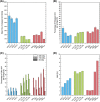Advanced Concepts in Rheology for the Evaluation of Hyaluronic Acid-Based Soft Tissue Fillers
- PMID: 33492870
- PMCID: PMC8078113
- DOI: 10.1097/DSS.0000000000002916
Advanced Concepts in Rheology for the Evaluation of Hyaluronic Acid-Based Soft Tissue Fillers
Abstract
Background: Crosslinked hyaluronic acid (HA)-based soft tissue fillers possess unique viscoelastic properties intended to match specific product indications. Manufacturing has an impact on HA chain integrity and on filler properties.
Objective: This study introduces 2 new rheological parameters to evaluate the macroscopic characteristics of fillers.
Methods and materials: A library of reference commercialized HA fillers was selected to cover the full spectrum of product indications. Gels were assessed in terms of size of released HA fragments as a readout of gel integrity, degree of modification, cohesivity, and rheological properties.
Results: The elastic modulus G' often used to characterize fillers was shown not to follow macroscopic mechanical properties. To improve the mechanical characterization of fillers, Strength and Stretch scores were developed and tested. The Strength score defined the ability of a filler to sustain constant viscoelasticity over a wide range of constraints and represented the filler mechanical resilience. The Stretch score measured the propensity of a filler to deform in view to improve implant adaptation to facial animation for natural-looking results.
Conclusion: Strength and Stretch scores sorted rheological parameters to macroscopic cohesivity assays more accurately than G' and may thus help predict the gel behavior once implanted and submitted to facial dynamics.
Copyright © 2021 The Author(s). Published by Wolters Kluwer Health, Inc. on behalf of the American Society for Dermatologic Surgery.
Conflict of interest statement
All authors are employed by Teoxane SA.
Figures


References
-
- Sánchez-Carpintero I, Candelas D, Ruiz-Rodríguez R. Dermal fillers: types, indications, and complications. Actas Dermo-Sifiliogr (English Edition) 2010;101:381–93. - PubMed
-
- Sadick N, Sorhaindo L. The utility of soft tissue fillers in clinical dermatology: treatment of fine wrinkles and skin defects. Expert Rev Med Devices 2007;4:559–65. - PubMed
-
- Beasley KL, Weiss MA, Weiss RA. Hyaluronic acid fillers: a comprehensive review. Facial Plast Surg 2009;25:86–94. - PubMed
MeSH terms
Substances
LinkOut - more resources
Full Text Sources
Other Literature Sources

